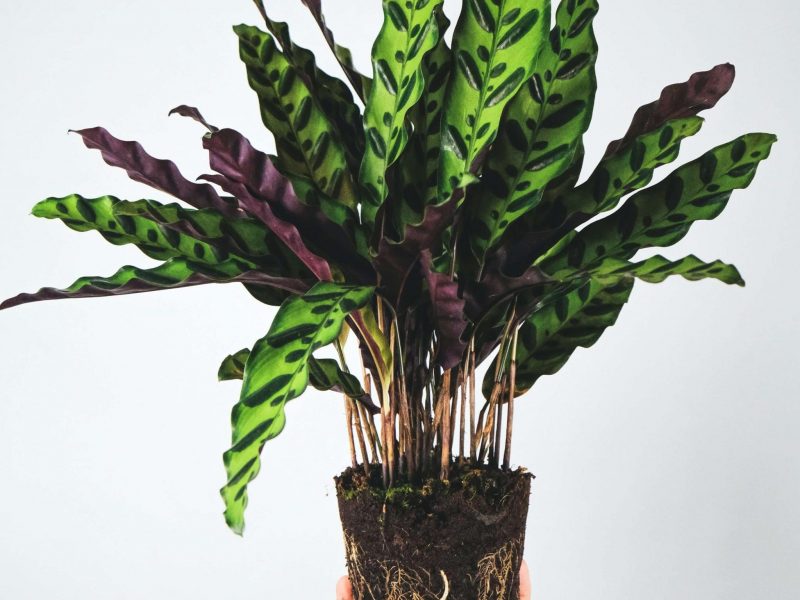
Repotting is one of the most forgotten aspects of plant care because a lot of emphases is often put on how much to water them and how much light they need. However, when not repotted for a long time, the roots can become overcrowded and this can start to cause real issues for your houseplants.
However, don’t fret as we have written this guide to tell you everything you need to know about when to repot your plant. Below you’ll find the telltale signs that your plant is in need of a bigger pot.
Roots are coming out the bottom of the pot
One of the easiest ways to know if your houseplant needs repotting is to check the underside of the pot to see if roots are growing out of the drainage holes. If yes, then this is a sign that your houseplant needs to be replanted into a larger pot as the space it has is not enough.
If there are only a few very small roots coming out of the drainage holes slightly, then you can probably wait a month or two if you have to but if more substantial roots are forming out of the pot then it’s time to repot now.
The reason for this is that when you repot a plant that has roots coming out of the drainage holes, there is a high chance that you might break a couple when removing the plant from the pot. If these are large roots then this can cause shock-related issues for your plant so it’s best to do it before it’s gotten to this point.
Roots visible on top of the soil
As well as roots growing out of the drainage holes at the bottom of the pot, if roots are popping out of the top of the pot then this can also indicate that your plant needs repotting. Often these are quite large and sturdy roots that come to the surface as the soil compacts so it’s important to cover these when you repot your plant so that they don’t become damaged.
Roots are tightly wrapped
Another way to know if your plant needs to be repotted into a larger pot is to remove it from its pot and check the root system. If the roots are very tightly wrapped in circles then it means the root system requires more space.
If the roots are still growing quite straight and there is a lot of potting mix then your plant doesn’t need to be repotted just yet.
We recommend removing your plant from its pot every so often so that you can check not only whether it needs repotting but also to check on the health of the root system. Most issues will start with the roots and will only progress to the rest of the plant once the issue has been going on for a while. By checking the root system it allows you to spot any problems quite early.
Growth is stagnant
If your houseplant hasn’t been growing any new leaves during the growth period of spring and summer then this can also suggest that it needs to be transplanted into a larger pot to give the roots more space to help the plant mature.
There can be other reasons though for stagnant growth so it’s worth checking the root system before making any changes.
If you’re seeing slow or stagnant growth during winter then don’t jump to the conclusion that your plant needs repotting. This is totally normal over the colder darker months of the year.
The pot looks too small for the plant
Aside from checking the root system, another obvious way to know if your plant needs repotting is by comparing the size of the pot to the plant. This is often clearer in bigger plants because sometimes it can look really odd for tall plants to have little tiny pots. This is an indication that your plant needs to be repotted into something bigger.
Plant losing leaves
If your houseplant is losing leaves, one of the issues could be that your plant is rootbound and cannot sustain the current leaves and new growth at the same time. Check the root system and other environmental aspects to confirm. It’s important that you don’t repot your plant until you are sure this is the issue as if there is something else going on, repotting an already struggling plant can cause more serious problems.
Our top tips for repotting your houseplant
Try to repot in spring
The best time of year to repot your plant is in spring. This is because there is plenty of sunny warm weather ahead to help your plant get over the shock of repotting and also make the most of the new space to grow new healthy bigger leaves.
If you have to repot in winter because of another issue then make sure that all other environmental factors such as sun, warmth and water are as close to what your plant needs as possible. This will help to minimise any problems caused by overwatering. LED grow lights can help in darker months.
Only increase pot size slightly
You might be thinking that choosing a much larger pot will avoid you having to repot any time soon and will give your plant plenty of space. However, it’s important that you only increase the pot size diameter by a few centimetres. This is for two reasons; firstly, larger pots mean more soil which takes a lot longer to dry out which can cause issues such as root rot and secondly too much extra soil can make your plant unstable.
Never reuse old potting mix from other plants
You might be tempted to reuse some old potting mix from some of your other plants when repotting but that can actually be risky. There can be a lot hiding in potting mix such as bacteria and pests that you will then expose your other plant to. This is why we always recommend using new soil.














